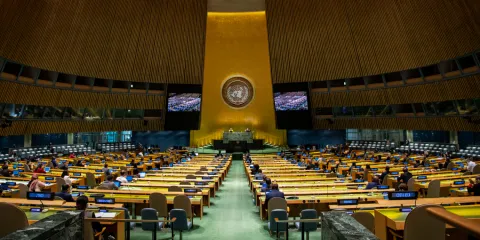A recap of UNGA75: an analysis

As the United Nations (UN) marked its seventy-fifth anniversary, the UN General Assembly (UNGA) was tasked with managing its first-ever virtual meeting while COVID-19 continued to wreak havoc around the globe.
This year, after several rounds of negotiation, Member States adopted the Omnibus COVID-19 Resolution which acknowledged and emphasised the critical role of the World Health Organization (WHO) and the United Nations (UN) system in 'catalysing and coordinating' the global response to COVID-19. It underscored the need for international cooperation and solidarity to contain and overcome the pandemic through responses that are people-centred.
UNGA also served as a convening ground for Member States to coordinate the development of science- and evidence-based interventions to combat COVID-19 and tackle the challenges to current and future development goals. While there were no high-level meetings dedicated to health this year, Member States utilised this opportunity to address the threats and challenges to development issues as a result of the pandemic.
In the race for a vaccine, a battle for equity
As countries turn their hopes to a vaccine, the biggest task for the UN is to encourage and ensure distribution equity.
WHO launched the Access to COVID-19 Tools (ACT) Accelerator platform for COVID-19 testing, treatment, and vaccine distribution. COVAX, the vaccine pillar of the ACT Accelerator, pools funding from donors to help develop and distribute a COVID-19 vaccine. With this effort, WHO and COVAX partner organisations like Gavi and CEPI hope to counter individual country efforts to secure millions of doses. So far, COVAX has pledges totalling 2 billion US dollars, and WHO estimates a total of 16 billion US dollars will be required.
Vaccines coming out of this initiative will be made available to all member countries with the initial doses being restricted to a maximum of 20 per cent allocated to the most vulnerable population groups in each of these countries. While an effective vaccine is desired and equitable distribution necessary, one of the biggest challenges faced by institutions and governments alike is 'vaccine hesitancy'.
Even before the pandemic, WHO identified 'vaccine hesitancy' as one of the 10 leading threats in global health and this will continue to be a challenge for tackling COVID-19 as governments secure vaccine doses.
Wider consequences of the pandemic - disrupted healthcare, poverty and hunger
Globally, public health systems remain fragile, essential medical supplies are hard to access and movement restrictions are destroying hard-fought health and economic gains. For people living with noncommunicable diseases (NCDs), prevention and treatment services that have been severely disrupted since the pandemic began. Service disruptions manifest in various ways including limited access to rehabilitation services, postponement of public screening programmes, cancellation of planned treatments, lack of staff due to reassignment and lack of health workforce capacity. This situation is particularly challenging given evidence of people living with NCDs (PLWNCDs) having a higher risk of severe COVID-19 related illness and death.
The complex relationship between COVID-19 and NCDs results in a syndemic that exacerbates existing inequality and poverty.
In addition to fragile health systems, food insecurity remains a challenge as millions are pushed into poverty. The World Food Programme estimates that the number of food-insecure people in at-risk countries could rise from 149 million pre-pandemic to 270 million by the end of the year if assistance is not provided immediately. The UN appealed for 10.3 billion US dollars to respond to the crisis but have yet to reach half this amount. In this context, the UN and other organisations are extremely under-resourced to mitigate, contain and provide relief during and after the pandemic.
Recent estimates also suggest that up to 6,000 children could die every day from preventable causes over the next six months as a result of pandemic-related disruptions to essential health and nutrition services.
UNGA Omnibus Resolution on COVID-19
The COVID-19 Omnibus Resolution was adopted ahead of UNGA75 after numerous rounds of negotiation with many countries disassociating from contentious paragraphs. The resolution was co-facilitated by Afghanistan and Croatia and was adopted by the assembly with only the United States and Israel voting against it.
The resolution was inspired and expands on the World Health Assembly resolution on COVID-19 response adopted earlier this year. On NCDs, the resolution includes language on universal health coverage (UHC), health systems strengthening, provision of services for NCDs and mental health and the involvement of people living with disabilities. In particular, the resolution calls on Member States to:
- Use a whole of government and a whole of society response to maintain health systems and strengthen primary healthcare, recognizing the importance of increased domestic financing and development assistance in achieving UHC;
- Ensure uninterrupted and safe provision of population and individual level services for NCDs and mental health;
- Strengthen efforts to address NCDs as a part of UHC and to recognize that PLWNCDs are at higher risk of developing severe COVID-19 symptoms and are among the most impacted by the pandemic;
- Prevent, monitor and address the impact of the pandemic on older persons to ensure the highest attainable standard of physical and mental health;
- Calls upon Member States and other stakeholders to include persons with disabilities in all stages of policy and decision-making related to COVID-19 response and recovery;
- Recognises the important role of civil society, including NGOs, women's and community-based, youth-led organisations, as well as the academic and scientific community and the private sector in COVID-19 response;
- Prioritise financing of the COVID response and UHC/PHC as a part of pandemic preparedness.